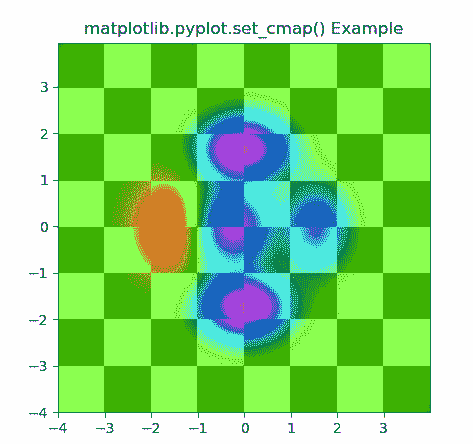Matplotlib.pyplot.set_cmap()用 Python
表示
原文:https://www . geeksforgeeks . org/matplotlib-pyplot-set _ cmap-in-python/
Matplotlib 是 Python 中的一个库,是 NumPy 库的数值-数学扩展。 Pyplot 是一个基于状态的接口到 Matplotlib 模块,它提供了一个类似于 MATLAB 的接口。Pyplot 中可以使用的各种图有线图、等高线图、直方图、散点图、三维图等。
matplotlib.pyplot.set_cmap()函数
matplotlib 库 pyplot 模块中的 set_cmap()函数用于设置默认的颜色映射,如果有则应用于当前图像。
语法:matplotlib . pyplot . set _ cmap(cmap)
参数:
- cmap : 此参数是 colormap 实例或注册的 colormap 的名称。
返回:该方法不返回值。
下面的例子说明了 matplotlib.pyplot.set_cmap()函数在 matplotlib.pyplot 中的作用:
例 1:
# Implementation of matplotlib function
import matplotlib.pyplot as plt
import matplotlib.tri as tri
import numpy as np
ang = 40
rad = 10
radm = 0.35
radii = np.linspace(radm, 0.95, rad)
angles = np.linspace(0, np.pi, ang)
angles = np.repeat(angles[..., np.newaxis],
rad, axis = 1)
angles[:, 1::2] += np.pi / ang
x = (radii * np.cos(angles)).flatten()
y = (radii * np.sin(angles)).flatten()
z = (np.sin(4 * radii) * np.cos(4 * angles)).flatten()
triang = tri.Triangulation(x, y)
triang.set_mask(np.hypot(x[triang.triangles].mean(axis = 1),
y[triang.triangles].mean(axis = 1))
< radm)
tpc = plt.tripcolor(triang, z,
shading ='flat')
plt.set_cmap("Greens")
plt.title('matplotlib.pyplot.set_cmap() Example')
plt.show()
输出:

例 2:
# Implementation of matplotlib function
import matplotlib.pyplot as plt
import numpy as np
from matplotlib.colors import LogNorm
dx, dy = 0.015, 0.05
x = np.arange(-4.0, 4.0, dx)
y = np.arange(-4.0, 4.0, dy)
X, Y = np.meshgrid(x, y)
extent = np.min(x), np.max(x), np.min(y), np.max(y)
Z1 = np.add.outer(range(8), range(8)) % 2
plt.imshow(Z1, cmap ="binary_r",
interpolation ='nearest',
extent = extent, alpha = 1)
def geeks(x, y):
return (1 - x / 2 + x**5 + y**6) * np.exp(-(x**2 + y**2))
Z2 = geeks(X, Y)
plt.imshow(Z2, alpha = 0.7,
interpolation ='bilinear',
extent = extent)
plt.set_cmap("gist_rainbow")
plt.title('matplotlib.pyplot.set_cmap() Example')
plt.show()
输出:

版权属于:月萌API www.moonapi.com,转载请注明出处
